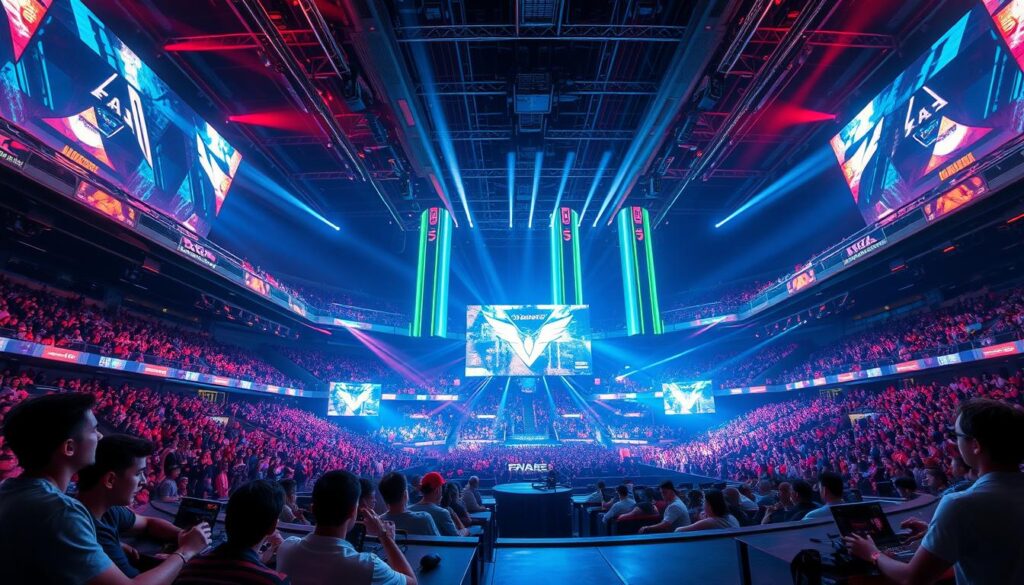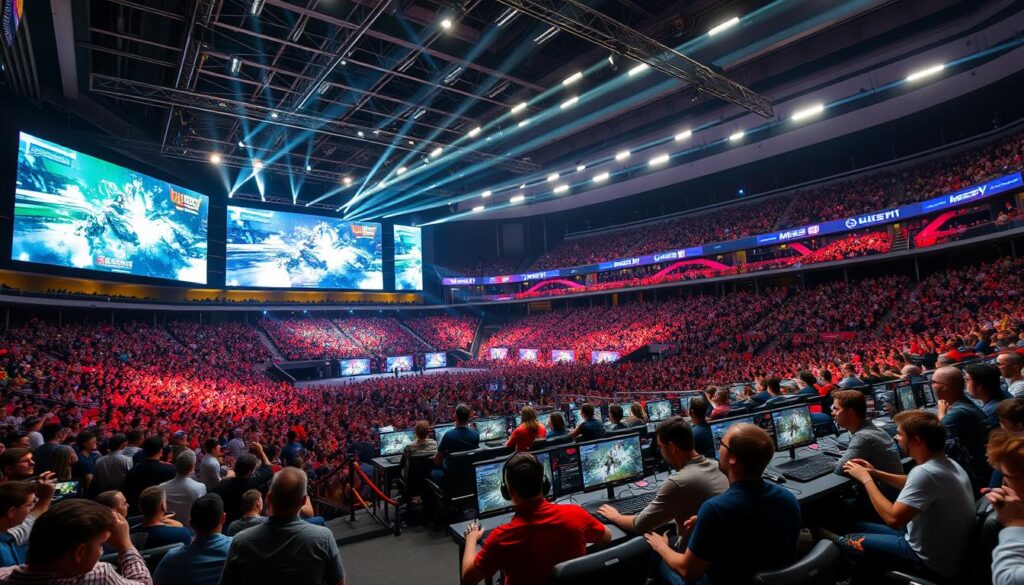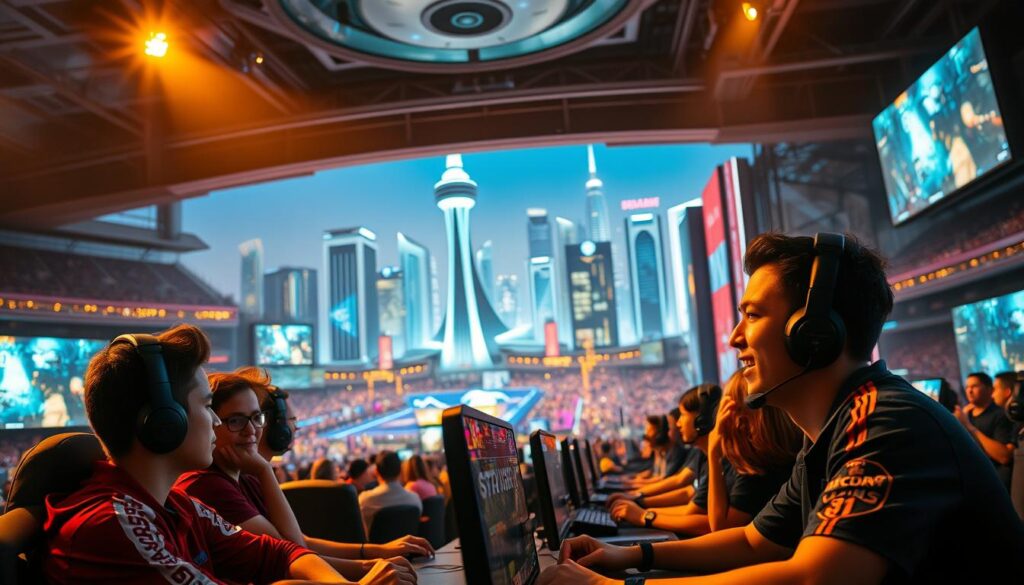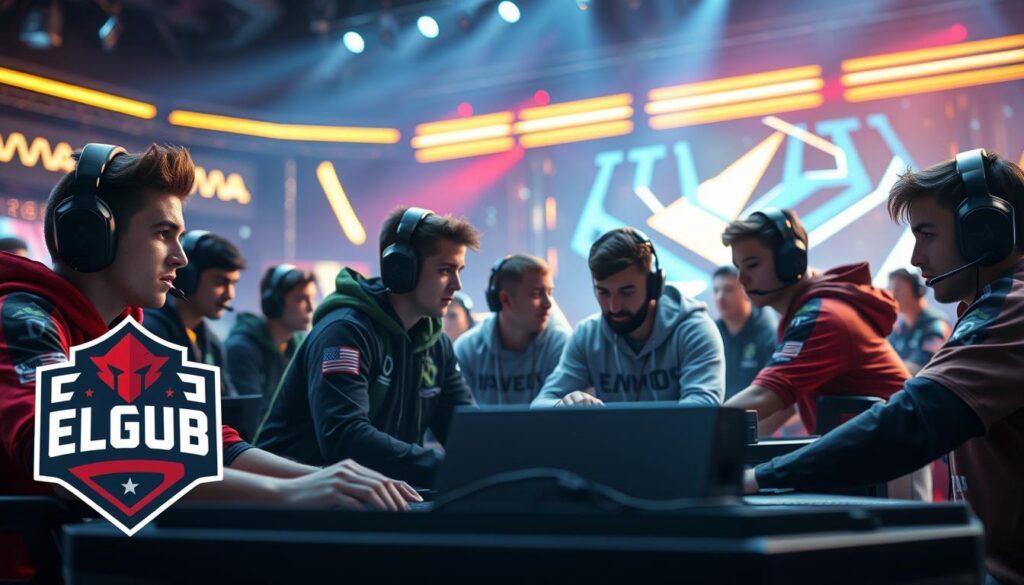Imagine a stadium as loud as Times Square on New Year’s Eve. But instead of athletes in jerseys, there are gamers with keyboards. This is the world of competitive gaming, where young players can become millionaires before they can legally drink. Victory margins are measured in milliseconds.
Let’s look beyond the hype of streaming platforms. A single event’s prize pool can be as big as a small country’s budget. For example, Dota 2’s $40M International is a huge deal. League of Legends’ World Championship even draws more viewers than the NBA Finals. And Fortnite’s creative destruction led to a $30M digital gold rush in 2019.
Why is this important? These events are more than just games. They’re cultural shifts that change how we think about entertainment. The mix of South Korean precision, Brazilian passion, and Silicon Valley tech is unique. You’ll find more drama in a Counter-Strike major than at a UN summit, with rivalries shown through headshot percentages.
So, get ready to learn about the world of esports. We’ll explore how gamers have built an empire that dwarfs Wimbledon’s prize money. And why your accountant might soon need to understand rocket league brackets.
Introduction: The Rise of Competitive Events
If you told a 90s kid their basement LAN parties would grow into a billion-dollar industry, they’d be shocked. The growth of esports tournaments is more than just bigger prizes or better venues. It’s a cultural shift. Think back when ESPN focused on football, not gaming stats? That all changed with Seoul’s massive LoL Park hosting finals.
South Korea’s Starcraft pros were the first to show the world what gamers could be. By the mid-2000s, players like Lim “BoxeR” Yo-Hwan were stars, with deals as big as K-pop idols. The West was slow to catch up, stuck in the “pizza-stained keyboards” era. Twitch changed everything, turning esports events into 24/7 entertainment for gamers.
Let’s look at the numbers like a Counter-Strike pro. Early 2000s tournaments offered prizes that barely covered a gamer’s snacks. Fast forward to 2024, and The International’s $40 million prize pool dwarfs the Stanley Cup. This isn’t just inflation—it’s a sign of esports’ growing importance.
The most interesting part? How Halo LAN parties gave birth to a generation that watches esports like the NFL. Universities now offer esports scholarships, and arenas sell out fast. Analysts debate strategies like Cold War generals. The revolution wasn’t televised; it was live-streamed in high definition.
Top Global Tournaments and Their Formats

Imagine esports tournaments as theme parks. The International is like a Vegas buffet, where fans help fund the prize pool. Counter-Strike’s Majors are like German trains, always on time but tough on teams that miss their mark. These events can make esports teams legends or failures, like a Twitch streamer’s WiFi.
The Overwatch League aimed to create cyborg athletes. It mixed sports season structure with Activision-Blizzard branding. But, it confused viewers more than a Rick and Morty episode.
Here’s how the big leagues compare:
- The International (Dota 2): Huge prize pools and a complex bracket system
- CS:GO Majors: Group stages that feel like Russian roulette
- League of Legends Worlds: A month-long competition with intense final eliminations
Why do these formats matter? They shape esports teams’ strategies. The International’s battle pass turns players into investors. Riot’s franchised leagues make teams more valuable than some countries.
“Modern esports formats are algorithmic cage matches – part sport, part reality TV production.”
Valve lets communities shape tournaments, while Epic Games controls Fortnite competitions. This creates a world where every game developer runs their own experiment with esports teams as subjects. It’s a wild ride.
Historic Prize Pools and Stand-out Moments
Esports tournaments now offer prize pools that could fund a small nation’s space program. This made people stop asking, “But is gaming a real career?”. Let’s look at the moments when competitive gaming turned from basement LAN parties to big events. These events have enough drama to make Shakespeare tweet “🔥”.
The $40 million Dota 2 International 2019 prize pool was a game-changer. Fans helped build this digital Colosseum through in-game purchases. This showed esports tournaments are more like fan-driven ecosystems than traditional sports. Ninja’s $1 million Fortnite solo win in 2019 also made waves, with parents Googling “How to uninstall Roblox.”
But it’s not just about the money. OG’s 2018 TI8 victory is like the Michael Jordan flu game of esports. Down to their last chance, this underdog squad made plays that seemed impossible. Their $11 million payday was just the icing on the cake.
| Tournament | Year | Prize Pool | Iconic Moment |
|---|---|---|---|
| The International (Dota 2) | 2019 | $34.3M | Crowdfunded by fans via Battle Pass |
| Fortnite World Cup | 2019 | $30M | 16-year-old Bugha’s solo domination |
| League of Legends Worlds | 2022 | $2.225M | DRX’s reverse sweep heard ‘round the world |
| CS:GO PGL Major Stockholm | 2021 | $2M | s1mple’s 47-kill nuclear performance |
These prize pools are more than just numbers. They’re cultural earthquakes. When a single esports tournament can outpay the Masters Golf purse, it’s clear where the next generation of athletes are looking. The real question? Which moment made you slam your desk so hard your coffee cup became a projectile?
Profiles of Legendary Champions
In the digital world, a few players have changed the game. They’ve turned joysticks into powerful tools. Let’s look at the strategies of esports’ greatest champions.

Faker (Lee Sang-hyeok) dominated League of Legends like no other. His three World Championship wins from 2015 to 2017 were all about strategy. He played like a chess master, always one step ahead.
s1mple (Oleksandr Kostyliev) is a CS:GO legend known for his incredible aim. His 2018 Faceit Major performance was a work of art. He hit 87% of his shots, showing incredible skill.
| Player | Game | Career Highlights | Signature Strategy |
|---|---|---|---|
| Faker | League of Legends | 3× World Champion | Map control through wave manipulation |
| s1mple | CS:GO | 13× HLTV MVP | Aggressive repositioning |
| Dendi | Dota 2 | TI1 Champion | Psychological baiting |
| Serral | StarCraft II | WCS Global Finals 2018 | 600 APM macro cycles |
Dendi (Danil Ishutin) of Na’Vi made Dota 2 a game of mind games. His Pudge hooks were like psychological attacks. His 2011 win was a lesson in strategic hero picks.
The Mythic Championship VI top contenders are pushing the game forward. They don’t just react; they plan ahead, often winning before the game even starts.
Serral (Joona Sotala) is a StarCraft legend known for his incredible speed. His 600 actions per minute are unmatched. Watching him play is like seeing Da Vinci paint while being attacked.
What makes these champions stand out? They don’t just play the game; they change it. Every win adds a new rule to the digital world. The question is, what new strategy will they bring next?
How Tournaments Shape the Scene
Imagine if Wall Street traders took advice from Counter-Strike pros. That’s not as crazy as it sounds. Esports tournaments don’t just show off skills; they change the rules of virtual worlds. Valve’s Majors have more influence on CS:GO’s market than the Federal Reserve does on interest rates.
A single tournament can make $3 million weapon skins worthless faster than saying “balance patch.”
These events are like gaming’s version of The Hunger Games, but with more keyboard warriors. The pressure forces teams to innovate or face extinction:
- Overwatch League’s 2021 “Double Shield” meta died overnight after tournament play exposed its weaknesses
- Dota 2’s infamous “6.83 Troll/Sniper” patch dominated pro circuits for 127 days before IceFrog nerfed it into meme status
- League of Legends’ 2023 MSI saw 43 champions banned – a record showing the meta’s volatility
“Tournaments turn ‘crazy ideas’ into standard playbooks. What’s considered broken today becomes tomorrow’s beginner tutorial.”
The financial stakes make these shifts even more intense. With a $40 million prize pool, teams will exploit every loophole. This creates a ripple effect where casual players get frustrated with strategies perfected in tournament labs.
But the real magic happens off-screen. Sponsorships grow, media rights deals increase, and college esports programs struggle to keep up with meta changes. It’s not just about who wins the trophy. It’s about reshaping an entire industry through competitive chaos.
How to Follow and Join Tournaments
Getting into esports tournaments is like trying to speedrun a game on expert mode. It gets harder as you go up. You need skill, strategy, and a lot of practice to make it big.
Discord is more than just for memes. It’s where teams practice hard to get better. You can find your team through:
- Game-specific subreddits (avoid the shitposting channels)
- Twitch streamer communities (pro tip: target mid-sized channels)
- Platform-specific hubs (FaceIt’s matchmaking discord doesn’t bite…much)
Now, let’s look at where you can prove yourself:
| Platform | Audience Reach | Skill Floor | Grind Factor |
|---|---|---|---|
| Twitch | Global exposure | Entertainment > mechanics | 7/10 (content creation marathon) |
| FaceIt | Competitive pool | CS:GO faceit level 6+ | 9/10 (soul-crushing ELO climb) |
| Local LANs | Regional recognition | Varies by event | 5/10 (but brings IRL networking) |
Analytics are key. Keep track of your stats like a stockbroker. If your K/D ratio hasn’t improved in 3 months, you might need to:
- Review match replays better (rookie mistake)
- Keep up with game changes (RIP double shield Overwatch)
- Get better internet (upgrade or perish)
“Pro contracts go to players who treat warm-ups like final exams and tilt like Buddhist monks.”
When you’re ready, start with small tournaments:
- Weekly online brackets (Battlefy hosts dozens)
- Collegiate leagues (yes, scholarships exist)
- Publisher-run circuits (Riot’s Valorant Challengers is 🔥)
Remember, if you’re getting interrupted by your mom’s cooking, you’re not ready. But if you can win a 1v5 match while your roommate plays loud music? You’re in the big leagues.
Conclusion
Esports tournaments are now as big as traditional sports. But the real question is how these digital arenas keep changing the game. Imagine VR battles where champions face motion sickness and AI teammates get benched.
The evolution of competitive gaming is leaving traditional sports in the dust. It’s like comparing dial-up internet to today’s fast speeds.
Universities now offer scholarships for League of Legends strategy. Cities build arenas where crowd cheers match in-game actions. The Fortnite World Cup made teenage millionaires, showing virtual athletes work hard.
When Olympic committees consider esports for medals, critics fall silent. What’s next? Hybrid leagues or blockchain prize pools? Esports is changing gaming culture and how we see skill and endurance.
You don’t need to play games to see where this is headed. Humanity wins, skepticism loses. GG.




